(404) 312-6640
The Owego Cruciform Casket Company
The waters of the mighty Susquehanna run cold and dark in March of the year. It’s not a place where you’d want to linger. And yet, a number of hardy men in small boats were navigating the dangerous currents undertaking the grim task of dragging the icy river. They were looking for something or someone that they hoped that they wouldn’t find. Sadly, their mission was successful.
By all accounts, John Van Kleeck was a tower of the Owego, New York community. Located among the rolling hills of Upstate New York’s lovely Southern Tier region Owego was then a bustling Victorian era community bisected by the Susquehanna River. Van Kleeck was a respected businessman; a “prominent Democrat”; and a former 3-term Tioga County Clerk. John was also the Secretary of and a principal stockholder in the new Owego Cruciform Casket Company, and therein lay the problem.
With its 2 impressive buildings over on Delphine Street, an electrified factory, a “can’t miss” patented product, and an air-tight marketing strategy the Owego Cruciform Casket Company had been launched with much local excitement and fanfare. They offered a diverse product line including building materials, lumber, shingles, and, of course, their signature product…caskets made in the shape of crosses.
But now…John was missing. Rumors had been circulating among the employees about troubles at the casket company. Business was lagging. Finances were strained. The year before, in 1889, Van Kleeck had been forced to make a personal assignment to keep the company operational. Instead of improving, things only got worse. The night before his disappearance Van Kleeck was seen wandering the streets of Owego in a “dazed condition”. Around 8pm someone notified the police about hearing a loud splash coming from the river. At 3PM the next day, March 18, 1890, John Van Kleeck’s body was pulled from the river. The Owego Daily Record newspaper speculated that Van Kleeck’s business reversals caused John’s mental derangement, and led to his eventual suicide.
The truism that John discovered back in 1890 continued to resonate across the succeeding 130 plus years… destroying more lives, and dashing countless business aspirations. You see, John learned the hard way that there is NO “easy money” to be made in the casket industry…not then, not now.
Our story begins not in Owego but in Moravia, New York, a small village nestled at the foot of Owasco Lake in Central New York State’s stunning Finger Lakes region. On April 11, 1882 local resident George Ferguson was granted US design patent #12880 for a casket. But, not just any casket. George’s improved burial receptacle was made in the shape of a cross with two “side projections” about where the shoulders of the deceased should fall. These side projections were meant to be “arm recesses”. It seems that George was none to happy with the body hugging coffins of the day. He designed his cross shaped casket to provide more space at the body’s widest part. George’s goal was a more natural and less cramped presentation of the deceased. Nowhere in George’s patent description is there any reference to a religious connotation regarding his creative design.
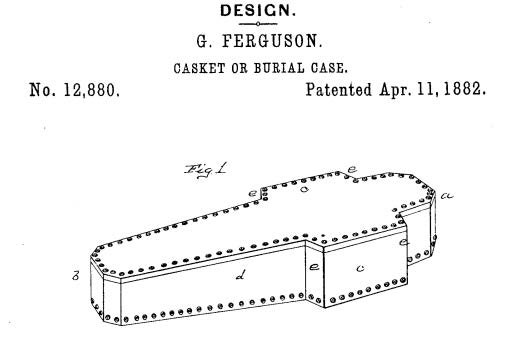
George founded the Cruciform Casket Company of Moravia, New York. Several prototypes were manufactured and high quality promotional cabinet card photos taken. These were then mounted on heavy cardboard with the name of his company stamped on the reverse. George then set about to locate distributors for his patented Cruciform Caskets. An early admirer
was John Marsellus, founder of the fledgling Marsellus Casket Company in Syracuse, New York. Indeed, the only 2 existing cabinet cards advertising The Cruciform Casket Company of Moravia, New York were found in the personal business files kept by John “Whiskers” Marsellus.
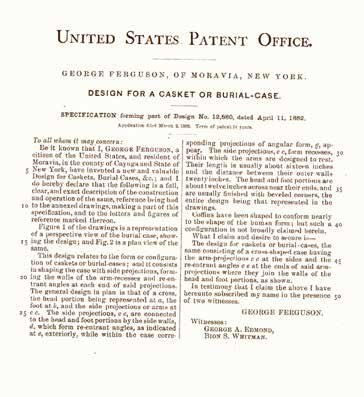
Other than the 2 photos there is no additional mention of The Cruciform Casket Company in any Marsellus records. One can assume that the Marsellus relationship with George Ferguson and his cross shaped caskets was extremely brief.
ENTER THE MARKETEERS!
While details of the transition are scant, sometime in 1883 George Ferguson sold or transferred his cruciform casket patent to a large lumber and building materials company down in Owego, New York. Known widely as producers of shingles, doors, lath, sashes, blinds, etc the owners envisioned a “can’t miss” opportunity to score big in the emerging factory-made hardwood casket business.
Driven by the belief that consumers would just die for the chance to select a casket that not only offered more room for their loved one, but also basically guaranteed the deceased a golden glide through the Pearly Gates courtesy of a casket shaped like a cross the lumbermen jumped in with both feet.
Enthusiasm ran high. The lumber yard owners changed their business name to the Owego Cruciform Casket Company. The February 8, 1884 issue of The Moravia Valley Register announced that the Owego Cruciform Casket Company had constructed 50 caskets, and was sending out agents on the road. The Company began to promote their new product. One large ad from the 1886 Official Minutes Year Book of the Methodist Episcopal Church, Wyoming Conference pulled no punches. The ad copy stated that “All religious denominations pronounce it the most appropriate form of casket yet made, and concede that it will become THE popular casket”. 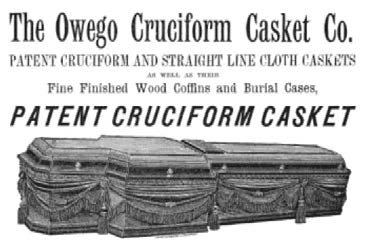
The Owego Cruciform Casket Company became an agent for Utopia, the “triumph” embalming fluid of the age out of Westport, Connecticut and Brooklyn, New York. They also added a complete line of undertaker’s supplies, robes, linings, etc. Realizing that cross shaped caskets may not be everyone’s cup of tea they also offered a line of more traditional shaped caskets with cloth covers, velvet covers, or natural wood finishes.
The Owego Cruciform Casket Company letterhead shows several impressive buildings, lumber storage sheds, and a train siding. A daily tradition at the Company was the flying of weather signal flags from the top of the main factory building announcing the local weather for the day…a very early version of the Weather Channel. Cleverly, the company printed promotional business cards with the Owego Cruciform Casket Company’s advertising on one side, and the key to the meaning of the varied weather signal flags on the reverse. Interestingly, only a single original OCCC business card has survived. It resides in the archives of the Tioga Historical Society.
The Tioga County Record of May 6, 1887 announced that the Owego Cruciform Casket Company was purchasing an electric light system for their factory with 50 electric arc lights. Installation was expected by September 1st of that year. At its height the company employed 33 males…2 of whom were under the age of 18.
They say that timing in life is everything. That may go double for business. In spite of their seemingly “heaven sent” marketing strategy and Management’s continued personal investments in the factory the business was on a downward spiral. While we may never know exactly why the Owego Cruciform Casket Company succumbed we can speculate that these issues didn’t help:
The great commercial panic or depression of 18821885 was still fresh in the minds of consumers and lenders. During this traumatic period business activity in the United States fell by 32.8%.
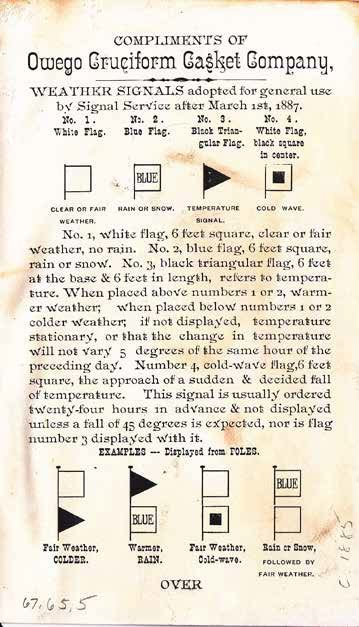 The factory-made American casket industry arguably got its start about 1853 with the introduction of Crane & Breed Manufacturing Owego Cruciform Casket Company business card Owego CCC 1887 Tioga Directory Company’s Ever Seal cast iron mummiforms based on the Fisk metallic patent. Incredibly, by the mid1880s the American casket industry was already grossly overproduced. Noting the early success of Crane and Breed every entrepreneur with a hammer and a saw decided to make his fortune in the casket business. Soon, even small towns often had 2 or more firms banging out caskets. Production far exceeded demand. The owners of the Owego Cruciform Casket Company walked into a competitive buzz saw. They encountered a terribly congested playing field in which to try to grow their new company…even with religion on their side.
The factory-made American casket industry arguably got its start about 1853 with the introduction of Crane & Breed Manufacturing Owego Cruciform Casket Company business card Owego CCC 1887 Tioga Directory Company’s Ever Seal cast iron mummiforms based on the Fisk metallic patent. Incredibly, by the mid1880s the American casket industry was already grossly overproduced. Noting the early success of Crane and Breed every entrepreneur with a hammer and a saw decided to make his fortune in the casket business. Soon, even small towns often had 2 or more firms banging out caskets. Production far exceeded demand. The owners of the Owego Cruciform Casket Company walked into a competitive buzz saw. They encountered a terribly congested playing field in which to try to grow their new company…even with religion on their side.
Radical new ideas in traditional industries rarely gain quick acceptance. This may be doubly true in the casket industry. One need only recall the incredibly creative Elder-Wilbert “space capsule” designed caskets of the 1970s; the numerous attempts to introduce Fiberglass/Composite/Plastic caskets starting way back with the National Mineralite and then the National Compudor caskets; caskets made from glass by American Glass Casket, and by DeCamp Consolidated; Springfield Metallic’s Eternalloy Seamless Cast Iron caskets; etc. All seemed like wonderful ideas yet all had the same ultimate fate…market rejection.
The suicide of Secretary Van Kleeck was followed shortly by the company’s receivership filed in January of 1891. J. A. Bassett, the appointed receiver, claimed that the Owego Cruciform Casket Company had $24,000 in assets versus $53,000 in liabilities. The company was eventually purchased at an assignee’s sale by the Owego National Bank for $3,300 as reported in The Tioga County Record, December 17, 1891. This sale closed the lid on one of the most creative caskets ever produced by the American casket industry. Sadly, creativity didn’t equal success.
And, what became of our inventor friend George Ferguson? George wasn’t done with the funeral industry yet. On February 18, 1890 George was granted patent #421,393 for an improvement in portable embalming tables. George’s vision was basically to offer an embalming table that could be adjusted to various lengths as needed by building 2 tongue-in-groove boxes that could be closed with one part sliding inside the other. George felt that the traveling embalmer could put their “implements and apparatus” inside the table and slide the ends together making a tidy little package to carry everything you need. Based on the patent diagram it appears that George’s “portable” table had to weigh a ton especially loaded with tools. Since no one has seen or heard of a Ferguson Sliding Embalming Table today we can only assume that George’s second foray into Funeral Service was even less successful than his first.
Now, this should be the end of our tale but…it isn’t. A while back I received a call from a woman in Owego who had seen an ad online for the 2013 Casket & Funeral Supply Association of America’s 100th Anniversary commemorative book which contains an article that I wrote entitled “A Brief History of the Funeral Supply Industry in the United States”. She tracked me down and told me that she had an original Owego Cruciform Casket stretched out across her dining room table and would I like to see it? I’ll say! She had recently “unearthed” the casket at a local antique shop and understanding its rarity she snatched it. Her objective was to eventually present this treasure to the local Historical Society.
A day or two later I was standing awestruck and shaking my head in front of one of the most strangely wonderful caskets that I’d ever encountered. Covered in a rich burgundy Matelasse (French for quilted velvet) fabric my impression was that this 5 foot, 6 inch casket seemed to be going several directions all at once. There was a LOT going on versus a traditional rectangular casket design. It struck me that there was NOTHING subtle about a Cruciform Casket! In addition, with all of the chamfers, sloping angles, and odd miter cuts constructing one of these caskets had to be a cabinetmaker’s worst nightmare. I lost count of the many different shaped component parts and moldings needed to complete the design. The flat top panel featured a “slip cap” that lifted off for viewing.
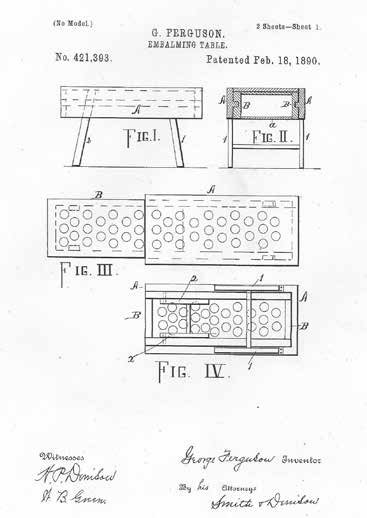 I took out my tape measure and was pretty surprised to find that the cavity for the deceased’s head was only 13.5” wide inside. The overall inside width at the “cross” was a scant 21”. At the foot end the inside width was only 13”. Now, granted this was one of their 5’6” models but, that said, a body laid out in one of these Cruciform caskets would have looked very untraditional indeed. And, herein just might lay the primary reason for the Cruciform casket’s failure to “catch on” with the public. In a Cruciform casket the deceased had to look anything but “natural”. While the concept of a religious casket certainly had appeal the fact that the casket gave the deceased a decidedly unappealing, compartmentalized appearance during viewing had to make families think twice before making their selection.
I took out my tape measure and was pretty surprised to find that the cavity for the deceased’s head was only 13.5” wide inside. The overall inside width at the “cross” was a scant 21”. At the foot end the inside width was only 13”. Now, granted this was one of their 5’6” models but, that said, a body laid out in one of these Cruciform caskets would have looked very untraditional indeed. And, herein just might lay the primary reason for the Cruciform casket’s failure to “catch on” with the public. In a Cruciform casket the deceased had to look anything but “natural”. While the concept of a religious casket certainly had appeal the fact that the casket gave the deceased a decidedly unappealing, compartmentalized appearance during viewing had to make families think twice before making their selection.
The Owego Cruciform Casket Company…proof once again that a great idea on paper doesn’t always translate to a successful real-life application. Still, who among us can’t help but smile as we consider and perhaps admire the dream, the creativity, and the courage that it took to give us caskets shaped like crosses…if only for a little while.

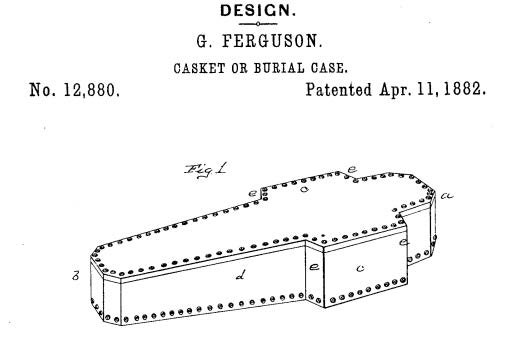



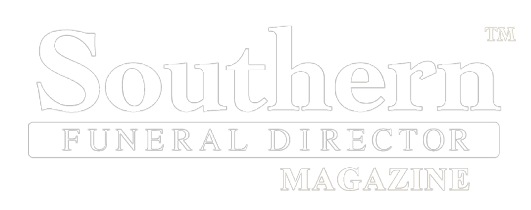
Comments